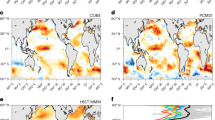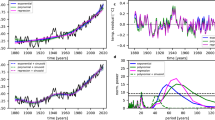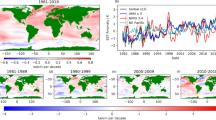Abstract
The twentieth-century trend in global-mean surface temperature was not monotonic: temperatures rose from the start of the century to the 1940s, fell slightly during the middle part of the century, and rose rapidly from the mid-1970s onwards1. The warming–cooling–warming pattern of twentieth-century temperatures is typically interpreted as the superposition of long-term warming due to increasing greenhouse gases and either cooling due to a mid-twentieth century increase of sulphate aerosols in the troposphere2,3,4, or changes in the climate of the world’s oceans that evolve over decades (oscillatory multidecadal variability)2,5. Loadings of sulphate aerosol in the troposphere are thought to have had a particularly important role in the differences in temperature trends between the Northern and Southern hemispheres during the decades following the Second World War2,3,4. Here we show that the hemispheric differences in temperature trends in the middle of the twentieth century stem largely from a rapid drop in Northern Hemisphere sea surface temperatures of about 0.3 °C between about 1968 and 1972. The timescale of the drop is shorter than that associated with either tropospheric aerosol loadings or previous characterizations of oscillatory multidecadal variability. The drop is evident in all available historical sea surface temperature data sets, is not traceable to changes in the attendant metadata, and is not linked to any known biases in surface temperature measurements. The drop is not concentrated in any discrete region of the Northern Hemisphere oceans, but its amplitude is largest over the northern North Atlantic.
This is a preview of subscription content, access via your institution
Access options
Subscribe to this journal
Receive 51 print issues and online access
$199.00 per year
only $3.90 per issue
Buy this article
- Purchase on Springer Link
- Instant access to full article PDF
Prices may be subject to local taxes which are calculated during checkout



Similar content being viewed by others
References
Trenberth, K. et al. in Climate Change 2007: The Physical Science Basis. Contribution of Working Group I to the Fourth Assessment Report of the Intergovernmental Panel on Climate Change Ch. 3 (Cambridge Univ. Press, 2007)
Hegerl, G. et al. in Climate Change 2007: The Physical Science Basis. Contribution of Working Group I to the Fourth Assessment Report of the Intergovernmental Panel on Climate Change Ch. 9 (Cambridge Univ. Press;, 2007)
Tett, S. F. B. et al. Estimation of natural and anthropogenic contributions to twentieth century temperature change. J. Geophys. Res. 107, 4306 (2002)
Stott, P. A. et al. Observational constraints on past attributable warming and predictions of future global warming. J. Clim. 19, 3055–3069 (2006)
Knight, J. R., Allan, R. J., Folland, C. K., Vellinga, M. & Mann, M. E. A signature of persistent natural thermohaline circulation cycles in observed climate. Geophys. Res. Lett. 32, L20708 (2005)
Thompson, D. W. J., Kennedy, J. J., Wallace, J. M. & Jones, P. D. A large discontinuity in the mid-twentieth century in observed global-mean surface temperature. Nature 453, 646–649 (2008)
Thompson, D. W. J., Wallace, J. M., Jones, P. D. & Kennedy, J. J. Identifying signatures of natural climate variability in time series of global-mean surface temperature: methodology and insights. J. Clim. 22, 6120–6141 (2009)
Schlesinger, M. E. & Ramankutty, N. An oscillation in the global climate system of period 65–70 years. Nature 367, 723–726 (1994)
Delworth, T. L. & Mann, M. E. Observed and simulated multidecadal variability in the Northern Hemisphere. Clim. Dyn. 16, 661–676 (2000)
Enfield, D. B., Mestas-Nuñez, A. M. & Trimble, P. J. The Atlantic Multidecadal Oscillation and its relation to rainfall and river flows in the continental U.S. Geophys. Res. Lett. 28, 2077–2080 (2001)
Sutton, R. T. & Hodson, D. L. R. Atlantic Ocean forcing of North American and European summer climate. Science 309, 115–118 (2005)
Trenberth, K. E. & Shea, D. J. Atlantic hurricanes and natural variability in 2005. Geophys. Res. Lett. 33, L12704 (2006)
Baines, P. G. & Folland, C. K. Evidence for a rapid global climate shift across the late 1960s. J. Clim. 20, 2721–2744 (2007)
Jansen, E. et al. in Climate Change 2007: The Physical Science Basis. Contribution of Working Group I to the Fourth Assessment Report of the Intergovernmental Panel on Climate Change Ch. 6 (Cambridge Univ. Press, 2007)
Dima, M. & Lohmann, G. Evidence for two distinct modes of large-scale ocean circulation changes over the last century. J. Clim. 23, 5–16 (2010)
Worley, S. J., Woodruff, S. D., Reynolds, R. W., Lubker, S. J. & Lott, N. ICOADS release 2.1 data and products. Int. J. Climatol. 25, 823–842 (2005)
Woodruff, S. D. et al. ICOADS release 2.5: extensions and enhancements to the surface marine meteorological archive. Int. J. Climatol. 10.1002/joc.2103 (2010)
Zhang, R., Delworth, T. L. & Held, I. M. Can the Atlantic Ocean drive the observed multidecadal variability in Northern Hemisphere mean temperature? Geophys. Res. Lett. 34, L02709 (2007)
Dickson, R. R., Meincke, J., Malmber, S. A. & Lee, A. J. The “great salinity anomaly” in the northern North Atlantic 1968–1982. Prog. Oceanogr. 20, 103–151 (1988)
Brohan, P., Kennedy, J. J., Harris, I., Tett, S. F. B. & Jones, P. D. Uncertainty estimates in regional and global observed temperature changes: a new dataset from 1850. J. Geophys. Res. 111, D12106 (2006)
Rayner, N. A. et al. Improved analyses of changes and uncertainties in marine temperature measured in situ since the mid-nineteenth century: the HadSST2 dataset. J. Clim. 19, 446–469 (2006)
Kent, E. C., Woodruff, S. D. & Berry, D. I. WMO Publication No. 47 metadata and an assessment of observation heights in ICOADS. J. Atmos. Ocean. Technol. 24, 214–234 (2007)
Ishii, M., Shouji, A., Sugimoto, S. & Matsumoto, T. Objective analyses of sea-surface temperature and marine meteorological variables for the 20th century using ICOADS and the Kobe Collection. Int. J. Climatol. 25, 865–879 (2005)
Kaplan, A. et al. Analyses of global sea surface temperature 1856–1991. J. Geophys. Res. 103, 18567–18589 (1998)
Smith, T. M., Reynolds, R. W., Peterson, T. C. & Lawrimore, J. Improvements to NOAA's historical merged land–ocean surface temperature analysis (1880–2006). J. Clim. 21, 2283–2296 (2008)
Woodruff, S. D., Slutz, R. J., Jenne, R. L. & Steurer, P. M. A comprehensive ocean-atmosphere data set. Bull. Am. Meteorol. Soc. 68, 1239–1250 (1987)
Acknowledgements
D.W.J.T. and J.M.W. are supported by the National Science Foundation Climate Dynamics Program under budget numbers ATM-0132190 and ATM-0613082 (D.W.J.T.) and ATM-0812802 (J.M.W.). J.J.K. is supported by the Joint Department of Energy and Climate Change and Defra Integrated Climate Programme: DECC/Defra (GA01101).
Author information
Authors and Affiliations
Contributions
J.M.W. contributed to the text, to the analysis design, and to the physical interpretation of the results. J.J.K. contributed to the text, performed all analyses of the metadata, and provided assistance with the analyses in the main text. P.D.J. contributed to the text, provided guidance on the context of the results, and provided expertise on the data sets used in the analyses. D.W.J.T. designed and carried out the primary analyses and led the writing of the text.
Corresponding author
Ethics declarations
Competing interests
The authors declare no competing financial interests.
Supplementary information
Supplementary Information
This file contains Supplementary Information comprising a) The adjustment Methodology, b) Examination of the SST metadata and c) Generation of the regression map in Figure 3a. Also included are an additional reference and Supplementary Figures 1 - 2 with legends. (PDF 405 kb)
Supplementary Data
This file contains all the data used in this study. (A .tar file concatenates multiple files and places them into a single file. To extract the data type ‘tar–xvzf DATA.tar.gz’ at the ‘Unix’ or ‘Linux’ command prompt. This command will extract all of the files contained within DATA.tar.gz and place them in the current working directory. Descriptions of the data files and data sources are located in the extracted README.txt file.). (ZIP 51592 kb)
Rights and permissions
About this article
Cite this article
Thompson, D., Wallace, J., Kennedy, J. et al. An abrupt drop in Northern Hemisphere sea surface temperature around 1970. Nature 467, 444–447 (2010). https://doi.org/10.1038/nature09394
Received:
Accepted:
Issue Date:
DOI: https://doi.org/10.1038/nature09394
This article is cited by
-
Stable Southern Hemisphere westerly winds throughout the Holocene until intensification in the last two millennia
Communications Earth & Environment (2022)
-
Essential spawning grounds of Scottish herring: current knowledge and future challenges
Reviews in Fish Biology and Fisheries (2022)
-
Reassessing the relative role of anthropogenic aerosols and natural decadal variability in driving the mid-twentieth century global “cooling”: a focus on the latitudinal gradient of tropospheric temperature
Climate Dynamics (2022)
-
Cryotic climate conditions and their eventual implication in the high-mountain surface of the Nevado de Toluca volcano, Mexico
Journal of Mountain Science (2021)
-
The role of natural factors (part 2): Indian summer monsoon in climate change period—observation and CMIP5 models
Theoretical and Applied Climatology (2019)
Comments
By submitting a comment you agree to abide by our Terms and Community Guidelines. If you find something abusive or that does not comply with our terms or guidelines please flag it as inappropriate.



